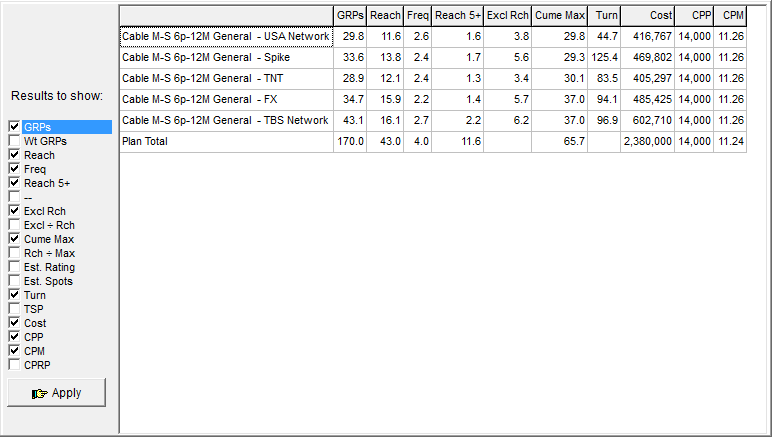Contributions (table)

This panel on the "Details" tab provides important information on each component in a plan. These measures can be helpful diagnostics for the value of each component in a television plan. They also can reveal or illustrate strengths or weaknesses of specific elements or networks. Some of the columns (GRPs, Wt. GRPs, Cost, CPP) are fairly self-explanatory. Here are the others:
Reach: |
The reach achieved by each component on its own. |
Exclusive reach: |
Reach that is attained by a component, but none of the others. If a line-item in a plansheet has a high exclusive cume, that bolsters an argument that it should be remain in the plan. (See more about exclusive reach in the Definitions topic.) |
Excl ÷ Rch: |
The exclusive reach divided by reach. This is a measure of how much of the component's total delivered reach was delivered uniquely by that component. |
Cume max: |
The potential reach that is possible for each component on its own. (This is not shown for added "other" media.) |
Rch ÷ Max: |
The component's reach divided by its own cume max. This is a good measure of how much of the potential of the component has been converted to actual reach (and thus, how much room there is for reach to expand further). |
Turnover: |
This is a component's cume max divided by its rating. A network that has high turnover needs more spots in order to achieve cume. On the other hand, this also means that you tend to get a fresh audience with each additional spot. |
Time Spent Percent: |
This is the flip side of turnover, and is computed as a component's rating divided by its cume max, and expressed as a percentage. A network with a shorter time spent generates more reach for the same number of spots. Or, a higher time spent percent could indicate a network generating a more loyal audience, or more long-form programming. |
CPRP: |
This is Cost Per Reach Point, the component's cost divided by its own reach. |
